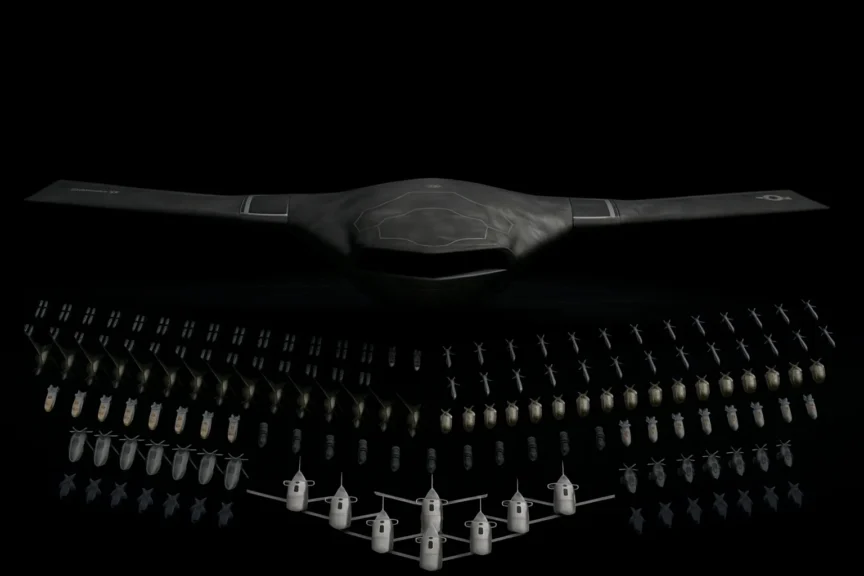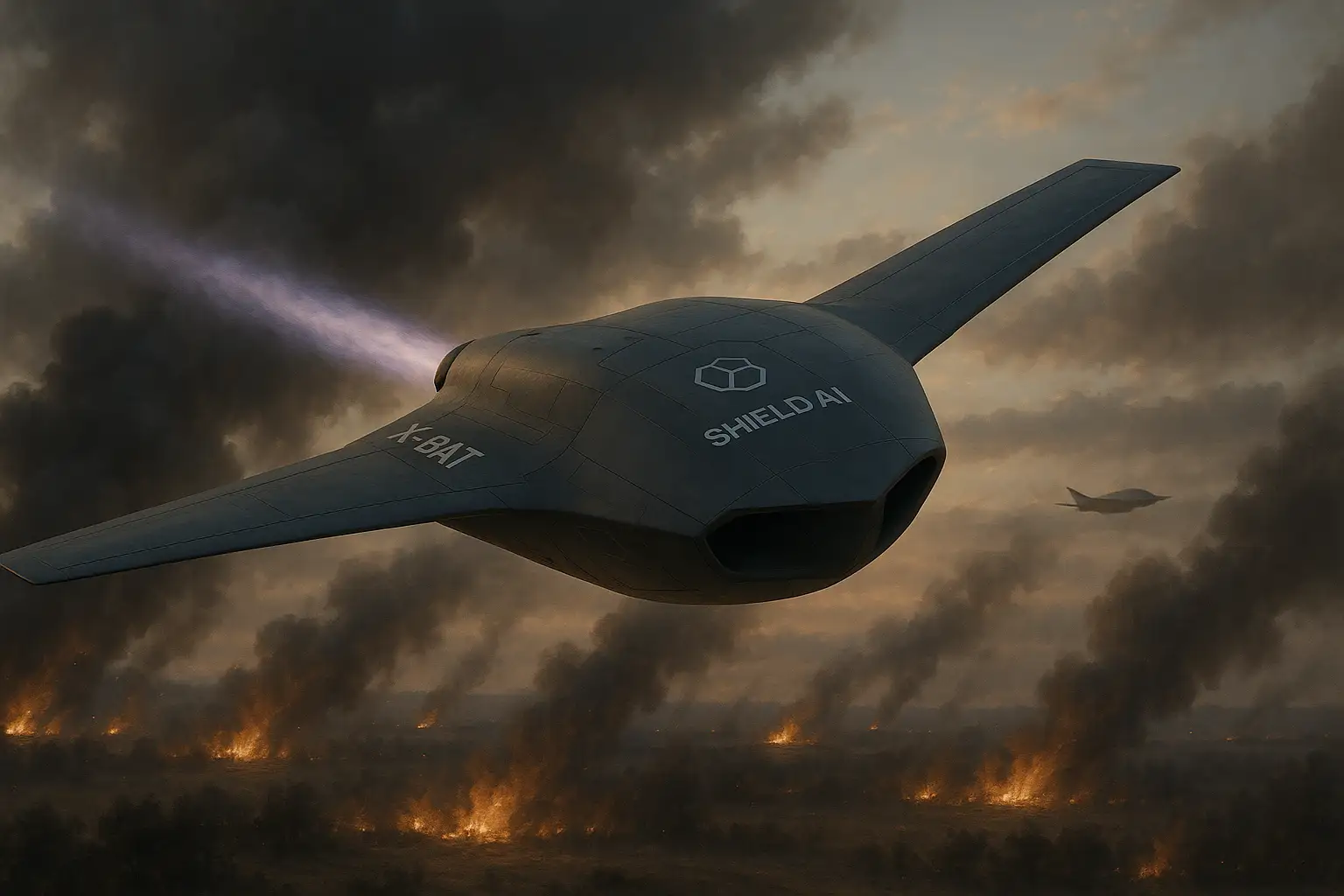When I first saw the concept, I realised it wasn’t just another drone.
The first time I read about the X-BAT by Shield AI, I felt an instant sense of curiosity. It wasn’t just another unmanned system; it appeared to be the next leap in air combat evolution.
As someone who follows defence technology closely, I knew this concept carried something deeper. The VTOL AI-powered strike jet is built not merely to fly but to think, decide, and adapt in real time.
It represents how nations like India can redefine air superiority, autonomy, and strategic reach in the modern battlefield.
What Exactly Is X-BAT?
The X-BAT by Shield AI is a Vertical Take-Off and Landing (VTOL) AI-powered strike jet developed by the American defence innovator Shield AI, a company known for pushing the boundaries of autonomous aviation.

Unlike traditional fighter aircraft, the X-BAT can lift off and land vertically from warships, mobile launch vehicles, or concealed forward bases.
It combines the intelligence and precision of a drone with the range, speed, and adaptability of a manned fighter, forming a new hybrid category of autonomous combat aircraft that is both agile and runway-independent.
Key Specifications at a Glance
| Feature | X-BAT Specification |
|---|---|
| Wingspan | 39 ft (11.9 m) |
| Length | 26 ft (7.9 m) |
| Service Ceiling | 50,000 ft + |
| Range | 2,000 nautical miles + |
| Flight Type | VTOL (Vertical Take-Off and Landing) |
| Software Brain | Hivemind AI Autonomy |
| Missions | Air-to-Air, Air-to-Ground, ISR, EW |
| Deployment | Runway-independent, ship or mobile base capable |

These details demonstrate how Shield AI is developing a cost-effective yet lethal platform that bridges the gap between manned fighters and high-end drones.
Why India Should Pay Attention
When I look at India’s geography, with its vast coastline, island territories, and high-altitude borders, the strategic importance of runway independence becomes undeniable.
The X-BAT by Shield AI could operate from a naval vessel in the Andaman Sea or a concealed forward base in the Himalayas, offering flexibility in deployment and rapid response in emergencies. Its vertical take-off capability aligns perfectly with India’s need for distributed, mobile, and intelligent airpower across varied terrain.
Key Advantages for India
- Operational flexibility in remote and forward areas
- Lower lifecycle cost compared to manned fighters
- Greater survivability through mobility and dispersion
- Scope for local manufacturing under the Make in India initiative
Defence analysts suggest that adopting such runway-independent systems could reduce forward-deployment risks by up to 40%, making every Indian Air Force squadron more agile and mission-ready in contested airspace.
How Shield AI’s Hivemind Redefines Autonomy
At the heart of the X-BAT by Shield AI lies Hivemind, an advanced AI system that gives the aircraft its true independence.
- Operates without GPS or control links: Hivemind enables the jet to fly, navigate, and engage targets in GPS-denied or communication-jammed environments using onboard sensors and adaptive algorithms.
- Learns and evolves: It continuously refines its decision-making by analysing mission data, allowing the jet to respond faster and more intelligently to threats.
- Coordinates with other drones: Through AI-driven swarm logic, Hivemind connects multiple aircraft into a single network that shares data and executes missions collaboratively.
- Proven in testing: According to Shield AI’s 2025 trials, Hivemind completed over 2,000 hours of autonomous flight, demonstrating stability and reliability in simulated combat conditions.
In essence, Hivemind transforms each X-BAT into a self-thinking combat unit, capable of analysing, adapting, and acting with the precision of a trained pilot.
The Evolution Beyond Traditional Jets
Conventional drones lack agility, while manned jets are costly. The X-BAT bridges this gap by being:
1. Flexible: Performs ISR, strike, and escort roles with modular payloads.
2. Affordable: Attritable design allows deployment in high-risk missions.
3. Portable: VTOL ability means no dependency on traditional airstrips.
4. Collaborative: Acts as a loyal wingman to manned fighters or operates as a fully autonomous squadron.
This combination positions X-BAT as the future workhorse of AI-powered combat aviation.
How X-BAT Compares with Other AI Combat Jets
| Aircraft | Origin | Range | Type | Autonomy Level |
|---|---|---|---|---|
| X-BAT | USA | 2000 nm+ | VTOL | High (Hivemind) |
| MQ-28 Ghost Bat | Australia | 1800 nm | Runway-based | High |
| Ghatak UCAV | India | 1000 km | Runway-based | Moderate |
| CATS Warrior | India | 1500 km | Assisted Take-Off | Moderate-High |
The X-BAT stands apart due to its runway independence, extended range, and fully self-piloted design; an edge few nations possess.
Also Read: Ghatak UCAV: India’s Stealth Drone
Explore: India’s HAL CATS Warrior UCAV Unveiled
The Global Race for VTOL AI Jets
Across the world, nations are investing in AI-based VTOL and stealth drone systems. The United States, Japan, the UK, and China are advancing similar concepts.
For India, exploring technologies like the X-BAT is essential to remain competitive in the AI combat era. The aircraft’s blend of autonomy, speed, and independence makes it ideal for next-generation multi-domain warfare.
Emerging Global Trends
- AI teaming systems are replacing conventional drone pilots
- Attritable combat aircraft lowering replacement costs
- Stealthy VTOL drones for maritime and border operations
If India adopts X-BAT early, could it become Asia’s first AI-airpower nation?
Geopolitical Context: India, the US, and Future Air Alliances
Every new weapon also reshapes diplomacy.
The X-BAT could become a symbol of the evolving India-US defence partnership, especially under initiatives like INDUS-X and iCET that promote joint innovation.
A collaboration around X-BAT aligns with both countries’ interests:
- India gains access to frontline AI combat technologies
- The US secures a trusted Indo-Pacific ally to balance China’s rise
- Shared research, co-production, and training frameworks strengthen interoperability
In this sense, the X-BAT isn’t just a jet; it’s a strategic handshake between democracies, shaping how freedom and deterrence coexist in Asia’s skies.
How Narsimha UAV NS-1200: India’s First VTOL Tailsitter Drone will transform India’s air power?
India’s Deadliest drone yet: Rudrastra UAV: India’s Deadliest VTOL Drone
Challenges and Realities on the Ground
While X-BAT’s promise is powerful, several challenges remain.
Developmental Maturity
Its first VTOL flight is due in 2026, with combat readiness expected by 2028. Testing and certification will determine its viability.
Integration Barriers
India’s command systems and data networks will need upgrades to align with such autonomous warfare platforms.
Policy and Export Constraints
US export regulations and technology-sharing rules may slow deeper collaboration unless addressed through new frameworks.
Still, these challenges are stepping stones, not stop signs. They represent the price of progress in modern defence innovation.
The Future of Aerial Warfare
Tomorrow’s battlefield won’t be about lone jets or pilots; it will be about coordinated intelligence.
Imagine a future where an Indian Rafale commands a formation of Tejas Mk1As and AI-driven X-BATs; each operating seamlessly under one networked command.
Projects like DRDO’s Ghatak UCAV and CATS Warrior show India’s readiness for this transformation. The X-BAT could act as a catalyst, connecting indigenous projects with global expertise.
IIT Bombay’s GPS-Free Drone Swarm Breakthrough Redefines Autonomous Flight
My Perspective: What X-BAT Truly Represents
For me, the X-BAT symbolises a deeper truth, that air power is evolving from muscle to mind.
It’s not just about speed or stealth anymore. It’s about adaptability, autonomy, and intelligence.
India has the scientific talent and strategic need to lead this transition. If the IAF engages early, it could shape doctrine and training around human-AI collaboration rather than follow others later.
The X-BAT is a reminder that the next warplane won’t just fly; it will learn.
Conclusion: A Smart Jet for a Smart Air Force
The X-BAT by Shield AI marks a historic leap in aviation, an aircraft that merges AI, autonomy, and versatility.
For India, it presents a unique opportunity to integrate AI-driven VTOL technology into its modernisation roadmap. It’s more than a purchase; it’s a strategic evolution.
In the decade ahead, air supremacy will belong not to the fastest jet, but to the smartest network. The X-BAT embodies that shift, from flight to foresight.
FAQs
Q1. What makes X-BAT different from traditional fighter jets?
X-BAT takes off vertically, uses AI for combat decisions, and can operate from ships or mobile bases, giving it unmatched flexibility.
Q2. When will X-BAT enter service?
Shield AI plans the first VTOL test in 2026, with operational readiness by 2028–29.
Q3. Can India manufacture or co-develop X-BAT?
Yes. Under the INDUS-X and Make in India frameworks, India could explore local production and joint R&D opportunities.
Q4. What is Hivemind software used for?
Hivemind allows X-BAT to operate autonomously in denied environments and coordinate with other drones through AI-based teamwork.
